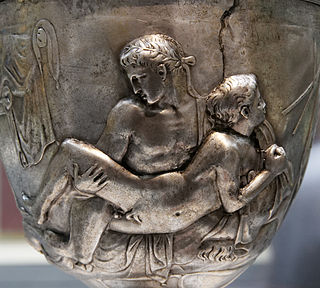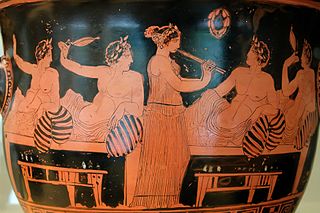
Demosthenes was a Greek statesman and orator of ancient Athens. His orations constitute a significant expression of contemporary Athenian intellectual prowess and provide an insight into the politics and culture of ancient Greece during the 4th century BC. Demosthenes learned rhetoric by studying the speeches of previous great orators. He delivered his first judicial speeches at the age of 20, in which he argued effectively to gain from his guardians what was left of his inheritance. For a time, Demosthenes made his living as a professional speech-writer (logographer) and a lawyer, writing speeches for use in private legal suits.

Solon was an Athenian statesman, lawmaker and poet. He is remembered particularly for his efforts to legislate against political, economic and moral decline in archaic Athens. His reforms failed in the short term, yet he is often credited with having laid the foundations for Athenian democracy. He wrote poetry for pleasure, as patriotic propaganda and in defence of his constitutional reforms.
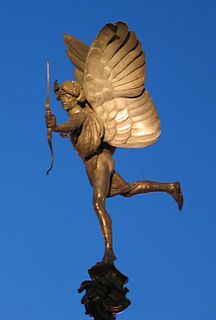
In Greek mythology, Anteros was the god of requited love, literally "love returned" or "counter-love" and also the punisher of those who scorn love and the advances of others, or the avenger of unrequited love.

In Greek mythology, Cyparissus or Kyparissos was a boy beloved by Apollo, or in some versions by other deities. In the best-known version of the story, the favorite companion of Cyparissus was a tamed stag, which he accidentally killed with his hunting javelin as it lay sleeping in the woods. The boy's grief was such that it transformed him into a cypress tree, a classical symbol of mourning. The myth is thus aetiological in explaining the relation of the tree to its cultural significance.

Aspasia was an influential immigrant to Classical-era Athens who was the lover and partner of the statesman Pericles. The couple had a son, Pericles the Younger, but the full details of the couple's marital status are unknown. According to Plutarch, her house became an intellectual centre in Athens, attracting the most prominent writers and thinkers, including the philosopher Socrates. There are also suggestions in ancient sources that the teachings of Aspasia influenced Socrates. Aspasia is mentioned in the writings of Plato, Aristophanes, Xenophon, and others.

Aeschines was a Greek statesman and one of the ten Attic orators.

Harmodius and Aristogeiton were two lovers from ancient Athens. They became known as the Tyrannicides after they killed the Peisistratid tyrant Hipparchus, and were the preeminent symbol of democracy to ancient Athenians.

In classical antiquity, writers such as Herodotus, Plato, Xenophon, Athenaeus and many others explored aspects of homosexuality in Greece. The most widespread and socially significant form of same-sex sexual relations in ancient Greece was between adult men and pubescent or adolescent boys, known as pederasty. Though sexual relationships between adult men did exist, at least one member of each of these relationships flouted social conventions by assuming a passive sexual role. It is unclear how such relations between women were regarded in the general society, but examples do exist as far back as the time of Sappho.

Greek Homosexuality is a book about homosexuality in ancient Greece by the classical scholar Kenneth Dover, in which the author uses archaic and classical archaeological and literary sources to discuss ancient Greek sexual behavior and attitudes. He addresses the iconography of vase paintings, the speeches in the law courts, and the comedies of Aristophanes, as well as the content of other literary and philosophical source texts.

Pederasty in ancient Greece was a socially acknowledged romantic relationship between an adult male and a younger male usually in his teens. It was characteristic of the Archaic and Classical periods. The influence of pederasty on Greek culture of these periods was so pervasive that it has been called "the principal cultural model for free relationships between citizens."

The relationship between Achilles and Patroclus is a key element of the stories associated with the Trojan War. Its exact nature has been a subject of dispute in both the Classical period and modern times. In the Iliad, Homer describes a deep and meaningful relationship between Achilles and Patroclus, where Achilles is tender toward Patroclus but callous and arrogant toward others. Homer never explicitly casts the two as lovers but they were depicted as lovers in the archaic and classical periods of Greek literature, particularly in the works of Aeschylus, Aeschines and Plato.
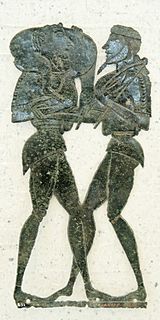
Cretan pederasty was an archaic form of pederasty that involved the ritual kidnapping (harpagmos) of a noble boy by an adult male of the aristocratic class, with the consent of the boy's father.

Prostitution was a common aspect of ancient Greece. In the more important cities, and particularly the many ports, it employed a significant number of people and represented a notable part of economic activity. It was far from being clandestine; cities did not condemn brothels, but rather only instituted regulations on them.
This is a history of same-sex unions in cultures around the world. Various types of same-sex unions have existed, ranging from informal, unsanctioned, and temporary relationships to highly ritualized unions that have included marriage. State-recognized same-sex unions have recently become more widely accepted, with various countries recognizing same-sex marriages or other types of unions.

Ancient Greeks used the word eros to refer to different aspects of love. This diverse range of meanings is expressed by the plurality of Greek words for Love, reflecting the versatility and complexity of eros. The term was used to describe not only the affectionate marital relationship between a man and a woman but also the institution of pedagogic pederastic relations, solemnized in certain Greek poleis. Such was the importance of eros for the ancient Greeks that the god of love, also named Eros, was held in Hesiod's cosmogony to be the primordial deity, the first god, older than all the others.
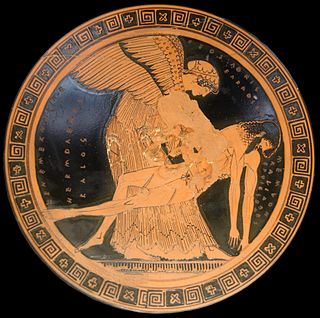
A kalos inscription (καλός) is a form of epigraph found on Attic vases and graffiti in antiquity, mainly during the Classical period from 550 to 450 BC. The word kalos (καλός) means "beautiful", and in the inscriptions it had an erotic connotation.

The Oinochoe by the Shuvalov Painter in the Antikensammlung at Berlin is an erotic depiction from ancient Greek vase painting.
The Lex Scantinia is a poorly documented ancient Roman law that penalized a sex crime (stuprum) against a freeborn male minor. The law may also have been used to prosecute adult male citizens who willingly took a passive role in having sex with other men. It was thus aimed at protecting the citizen's body from sexual abuse (stuprum), but did not prohibit homosexual behavior as such, as long as the passive partner was not a citizen in good standing. The primary use of the Lex Scantinia seems to have been harassing political opponents whose lifestyles opened them to criticism as passive homosexuals or pederasts in the Hellenistic manner.
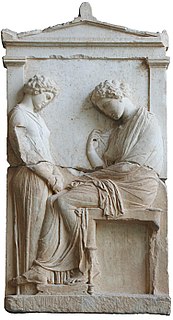
Slavery was a common practice in ancient Greece, as in other societies of the time. Some Ancient Greek writers considered slavery natural and even necessary. This paradigm was notably questioned in Socratic dialogues; the Stoics produced the first recorded condemnation of slavery.

